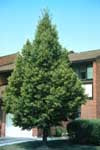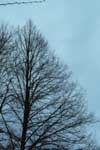 |
 |
 |
|
A 'Greenspire' Littleleaf linden G. Lumis |
The leaf and fruit of a Littleleaf linden G. Lumis |
A Littleleaf linden in winter G. Lumis |
Scientific Name: Tilia cordata
Foliage: Deciduous broadleaf
Height: 60 to 70 feet
Spread: 30 to 40 feet
Shape: Upright
Glossy, dark-green foliage in summer remains on tree long into fall. Summer flowers are small but fragrant.
Plant Needs
Zone: 3 to 8
Light: Partial shade to full sun
Moisture: Wet, moist, or dry
Soil Type: Sandy or loam
pH Range: 4.5 to 7.3
Functions
Suggested uses for this plant include shade and street tree.
Planting Notes
Transplants readily. Prefers moist, well-drained, fertile soil and full sun. Pollution tolerant.
Care
Tolerates pruning, but pruning is not required.
Problems
Japanese beetles, aphids, and a sooty mold which gives the tree a blackish appearance may occur.
Alternatives
Consult local sources, including historic or public gardens and arboreta, regarding cultivars and related species that grow well in your area.
Cultivars of TILIA CORDATA
`Greenspire' has a straight trunk and grows into a narrow, oval form.
`Chancellor' has a narrow, compact, upright form.
Related species
TILIA TOMENTOSA (Silver Linden) is a beautiful specimen tree that tolerates heat and drought better than other Lindens. Growing up to 50 to 70 feet tall and 25 to 40 feet wide.
Comments
Lindens are some of the best shade trees and are ideally suited to home situations. Small, yellowish summer flowers are not showy, but are highly fragrant. Small, round seeds hang on an interesting leafy bract and persist well into winter.
This material was developed by Carol Ness as part of the Interactive Design and Development Project funded by the Kellogg Foundation. Mary Miller, Project Director. Diane Relf, Content Specialist, Horticulture. Copyright 1989 by VCE.

